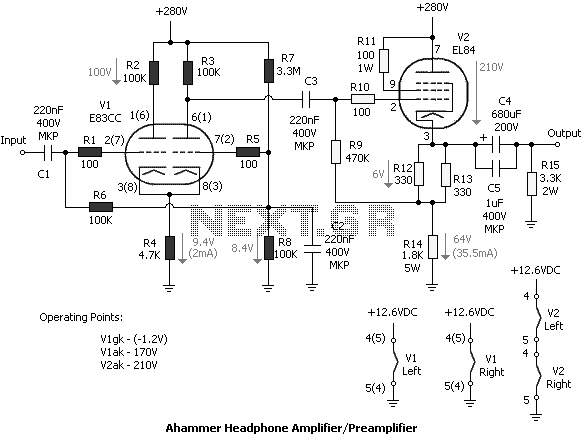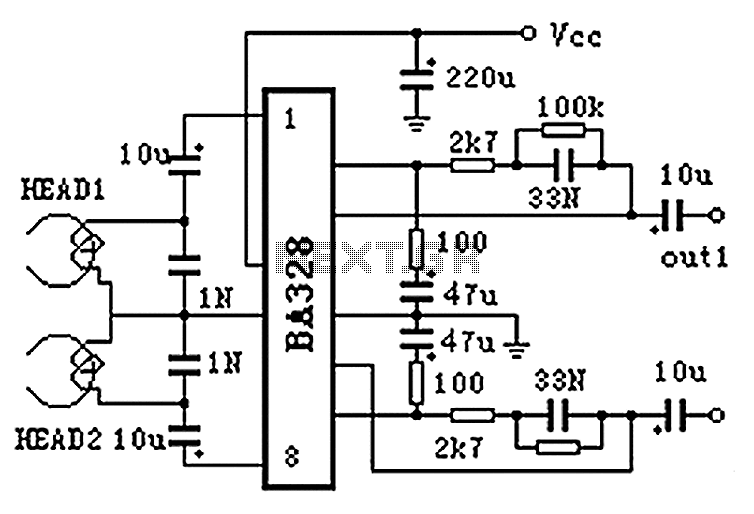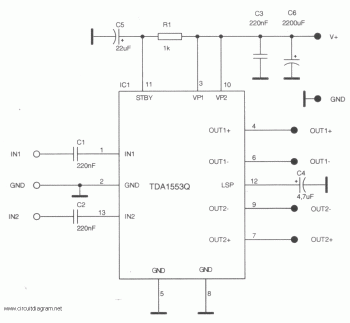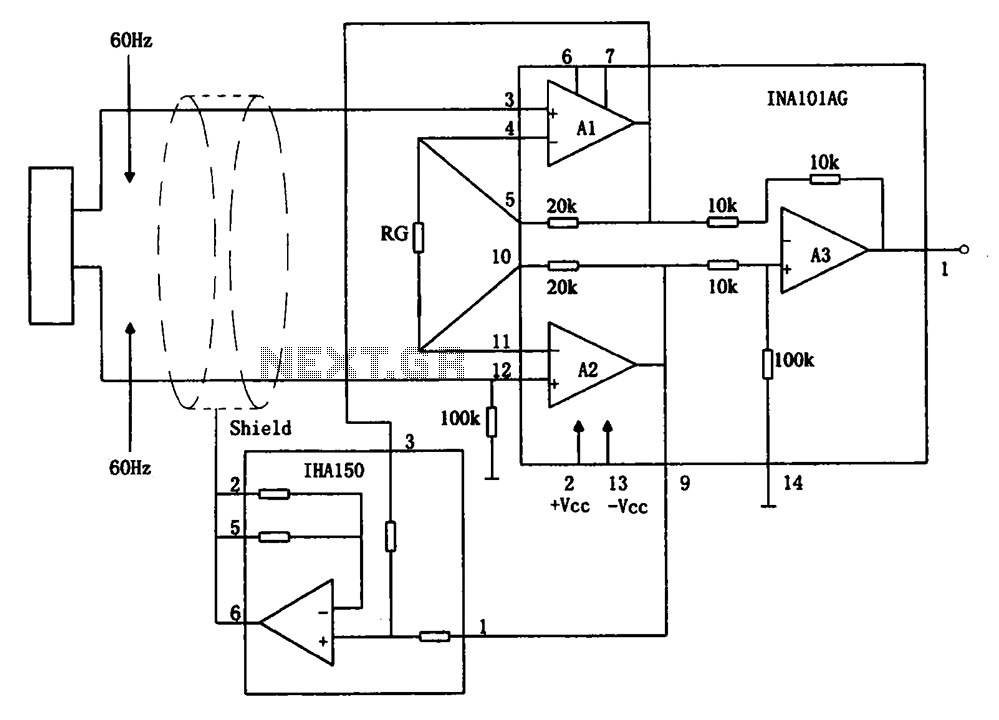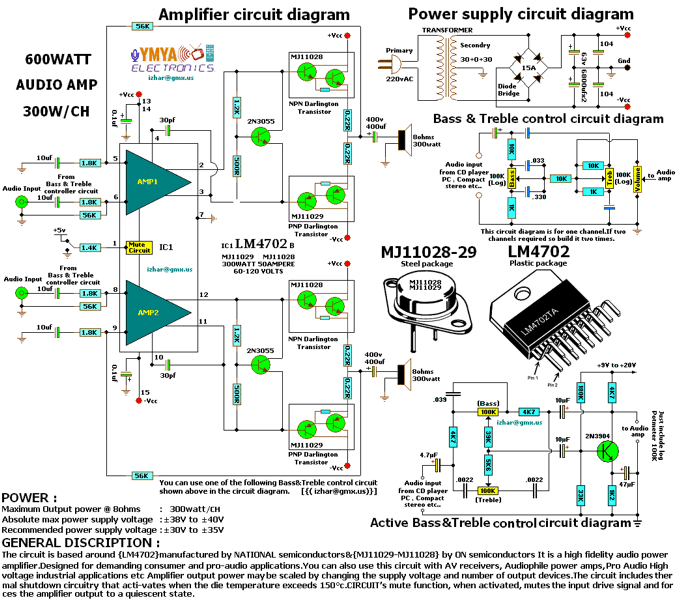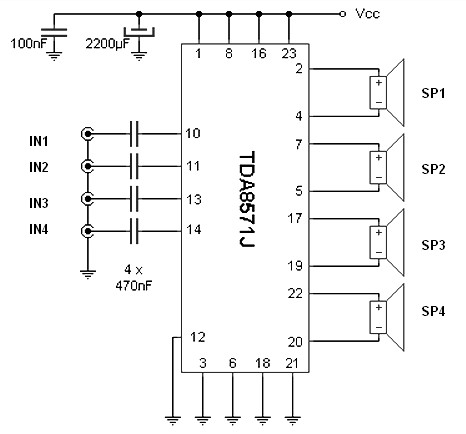
DIY Single-Ended (SE) 6L6 / 5881 Tube Amplifier
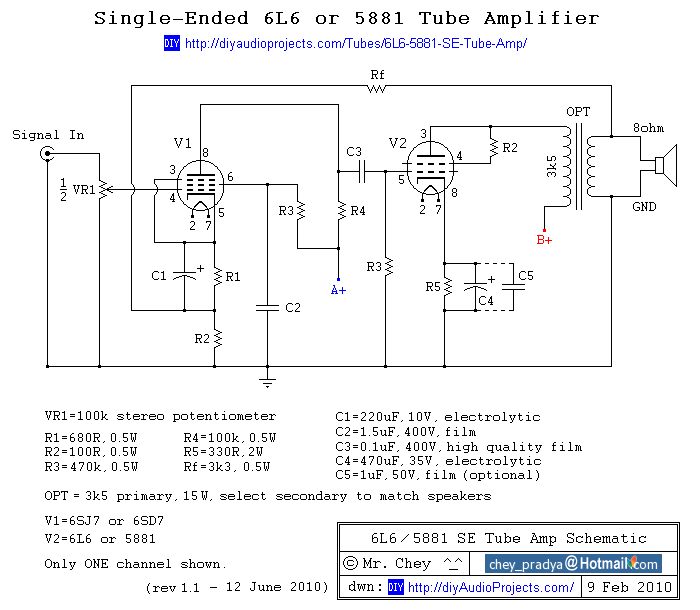
This past summer, an inspiration arose from watching "Transformers: Revenge of the Fallen" to construct an enclosure for a vacuum tube amplifier featuring the Decepticon logo. The tube amplifier replaces a solid-state amplifier that was driven by a tube preamplifier. The amplifier circuit employs a cutoff pentode (6SJ7 or 6SD7) driving a beam power pentode (6L6 or 5881) in a single-ended configuration (class-A operation). The schematic for the amplifier is quite similar to the one used in the first tube amplifier project. The circuit design is straightforward, adhering to basic application notes. The quality of the audio output transformer (OPT) significantly influences sound quality; a transformer with a 43% screen grid tap can facilitate ultra-linear operation. A high-quality capacitor (such as a film or paper-in-oil capacitor) is recommended for C3. This tube amplifier project operates at high voltage, and contact with high voltages poses serious risks. Individuals lacking experience in high voltage safety should refrain from undertaking this project. It is crucial to complete mains, ground, fuse, and switch connections according to local electrical codes. The high-tension (HT) power supply is solid-state, utilizing affordable UF4005 "ultra-fast" silicon rectifier diodes. Without a choke, multiple capacitors are employed to ensure a quiet HT supply. The heater supply is regulated to 6.3VDC using an LM338K adjustable voltage regulator, which requires a suitable heat sink due to its tendency to become hot; consulting the datasheet is advisable for determining the appropriate heat sink. Although alternating current (AC) may be used for the tube heaters, it may introduce higher noise levels. The enclosure is constructed from aluminum, which is easy to cut and manipulate. The sides are formed from a C-channel section, held together at the corners with cut-down angle sections. Aluminum sheets serve as the top and bottom of the chassis. With careful effort, an aesthetically pleasing enclosure can be built using minimal tools—a hand drill, hacksaw, file, and sandpaper. The OPT covers feature the Transformers logo, cut from copper clad board, which is glued onto the covers after being drawn and cut out. The OPT cover box is also made from copper clad board, assembled with solder and glue. Small copper legs are soldered to the OPT cover to ground the copper cladding, providing shielding for the output transformers. The finish on the OPT covers consists of metallic silver spray paint, cured under sunlight. The circuit employs homemade (hand-etched) circuit boards, although the simplicity of the tube amplifier allows for point-to-point wiring, especially if AC is used for heating the tubes. The LM338K regulator is electrically isolated and mounted to an aluminum angle, which is attached to the aluminum chassis, serving as an adequate heat sink. The chassis design includes space for three driver tubes, with an additional 9-pin miniature socket included for potential experimentation with an extra voltage gain stage or using a double triode tube (like the 12AX7 or 5751). After a break-in period, the sound quality of this tube amplifier has been appreciated. The amplifier utilizes new old stock (NOS) Tungsram 6SJ7GT driver tubes alongside new production Sovtek 5881WXT power tubes, which are well-suited for guitar rock music. For more refined genres like jazz, the JJ/Tesla 6L6GC power tubes deliver an excellent sound.
This vacuum tube amplifier circuit is designed around a single-ended, Class A configuration, which is known for its warm and rich audio characteristics. The use of a cutoff pentode as a driver stage allows for efficient amplification while maintaining a low distortion profile. The choice of output transformer is critical; the recommended 43% screen grid tap enhances linearity and overall audio fidelity. Capacitors used in the circuit should be selected for their low equivalent series resistance (ESR) and high voltage ratings to ensure reliability and performance.
The high-tension power supply is designed to provide stable voltage to the amplifier circuit, with the UF4005 diodes ensuring rapid rectification of the AC input. The absence of a choke in the power supply design is compensated by the use of multiple capacitors, which filter out any ripple and noise, providing a clean DC voltage to the amplifier. The regulated heater supply is essential for maintaining consistent performance across the tubes, and the LM338K regulator's mounting to a heat sink is a critical design consideration for thermal management.
The enclosure design not only serves an aesthetic purpose but also contributes to the overall performance of the amplifier by providing shielding from external electromagnetic interference. The copper clad board used for the OPT covers not only showcases the Transformers logo but also serves a functional role in grounding and shielding the output transformers.
Overall, this project emphasizes the importance of safety and adherence to electrical codes when working with high voltage components. The thoughtful selection of components and careful construction techniques will result in a high-quality vacuum tube amplifier, capable of delivering exceptional audio performance across a variety of musical genres.This past summer I saw Transformers: Revenge of the Fallen and I was inspired to build an enclosure for a vacuum tube amplifier that incorporated the Decepticon logo. The tube amplifier replaces a solid-state amplifier which was driven by a tube preamplifier. For the tube amplifier circuit I used a cutoff pentode (6SJ7 or 6SD7) driving a beam powe r pentode (6L6 or 5881) in a single-ended circuit (class-A operation). The amplifier schematic is very similar to the one I used for my very first tube amplifier. The amplifier circuit is very straight forward following the basic application notes. The quality of the audio output transformer (OPT) will have the largest effect on the sound quality. You can consider an OPT with a 43% screen grid tap to allow ultra-linear mode. Use a good quality capacitor (film, pio. ) for C3. This tube amplifier project uses high voltage and contact with high voltages can cause serious injury or death. If you are not experienced with high voltage safety and working with high voltage, this is not the project for you.
Please take electrical safety seriously. Complete the mains, ground, fuse and switch connections in accordance with your local electrical code. The high-tension (HT) power supply is solid state using inexpensive UF4005 "ultra-fast" silicon rectifier diodes.
Because I did not use a choke, several capacitors were used to create a quiet HT supply. For the heater supply I used direct current (DC) which is regulated to 6. 3VDC by a LM338K adjustable voltage regulator. The LM338 regulator gets rather hot so be sure to use a suitable heat-sink. Consult the data sheet to determine the heat-sink required. Of course you may use alternating current (AC) for the tube heaters, but it may result in a higher noise level. The tube amplifier enclosure is constructed using aluminum as it is easy to cut and work with. For the sides a C-channel section was cut down and held together at the corners using cut down pieces of angle (L) sections.
Aluminum sheets were used for the top and bottom of the chassis. If you take your time it is possible to build a very attractive enclosure with minimal tools - a hand drill, hacksaw, file and sandpaper. Here are some photos of the chassis construction. I had previously mentioned the Transformers movie and I wanted to put the logo on the audio output transformer (OPT) covers.
For the OPT covers I used copper clad board. The logo was drawn onto the board and I used small hand saw to cut the logo out which was glued to OPT covers. The OPT cover box is also built using the copper clad board and held together using solder and glue. By soldering small copper legs to the OPT cover the copper cladding is "grounded" and used to shield the output transformers.
The finish on the OPT covers is a metalic-silver spray paint and then baked in hot sunlight. For the circuit I used home made (hand etched) circuit boards, but the tube amplifier is so simple it can be easily connected with point-to-point wiring, especially if you choose to heat the tubes using AC. The LM338K regulator is mounted (with electrical isolation) to an aluminum angle which is in turn attached to the aluminum chassis which makes for an adequate heat-sink.
You may have noticed on the chassis that there is room for three driver tubes. I`ve included another socket (9-pin miniature socket shown and not connected) so I can later experiment with an additional voltage gain stage or driving the amp with a double triode tube (like 12AX7 or 5751). After giving a little time for the tubes to burn in I really warmed up to the sound from this tube amp.
I am using new old stock (NOS) Tungsram 6SJ7GT driver tubes with new production Sovtek 5881WXT power tubes. The Sovtek 5881WXT work well with guitar rock music but for more refined music like jazz the JJ / Tesla 6L6GC power tubes sound very nice.
This single-ended tube amplifier is a welcome replacement over the solid- 🔗 External reference
This vacuum tube amplifier circuit is designed around a single-ended, Class A configuration, which is known for its warm and rich audio characteristics. The use of a cutoff pentode as a driver stage allows for efficient amplification while maintaining a low distortion profile. The choice of output transformer is critical; the recommended 43% screen grid tap enhances linearity and overall audio fidelity. Capacitors used in the circuit should be selected for their low equivalent series resistance (ESR) and high voltage ratings to ensure reliability and performance.
The high-tension power supply is designed to provide stable voltage to the amplifier circuit, with the UF4005 diodes ensuring rapid rectification of the AC input. The absence of a choke in the power supply design is compensated by the use of multiple capacitors, which filter out any ripple and noise, providing a clean DC voltage to the amplifier. The regulated heater supply is essential for maintaining consistent performance across the tubes, and the LM338K regulator's mounting to a heat sink is a critical design consideration for thermal management.
The enclosure design not only serves an aesthetic purpose but also contributes to the overall performance of the amplifier by providing shielding from external electromagnetic interference. The copper clad board used for the OPT covers not only showcases the Transformers logo but also serves a functional role in grounding and shielding the output transformers.
Overall, this project emphasizes the importance of safety and adherence to electrical codes when working with high voltage components. The thoughtful selection of components and careful construction techniques will result in a high-quality vacuum tube amplifier, capable of delivering exceptional audio performance across a variety of musical genres.This past summer I saw Transformers: Revenge of the Fallen and I was inspired to build an enclosure for a vacuum tube amplifier that incorporated the Decepticon logo. The tube amplifier replaces a solid-state amplifier which was driven by a tube preamplifier. For the tube amplifier circuit I used a cutoff pentode (6SJ7 or 6SD7) driving a beam powe r pentode (6L6 or 5881) in a single-ended circuit (class-A operation). The amplifier schematic is very similar to the one I used for my very first tube amplifier. The amplifier circuit is very straight forward following the basic application notes. The quality of the audio output transformer (OPT) will have the largest effect on the sound quality. You can consider an OPT with a 43% screen grid tap to allow ultra-linear mode. Use a good quality capacitor (film, pio. ) for C3. This tube amplifier project uses high voltage and contact with high voltages can cause serious injury or death. If you are not experienced with high voltage safety and working with high voltage, this is not the project for you.
Please take electrical safety seriously. Complete the mains, ground, fuse and switch connections in accordance with your local electrical code. The high-tension (HT) power supply is solid state using inexpensive UF4005 "ultra-fast" silicon rectifier diodes.
Because I did not use a choke, several capacitors were used to create a quiet HT supply. For the heater supply I used direct current (DC) which is regulated to 6. 3VDC by a LM338K adjustable voltage regulator. The LM338 regulator gets rather hot so be sure to use a suitable heat-sink. Consult the data sheet to determine the heat-sink required. Of course you may use alternating current (AC) for the tube heaters, but it may result in a higher noise level. The tube amplifier enclosure is constructed using aluminum as it is easy to cut and work with. For the sides a C-channel section was cut down and held together at the corners using cut down pieces of angle (L) sections.
Aluminum sheets were used for the top and bottom of the chassis. If you take your time it is possible to build a very attractive enclosure with minimal tools - a hand drill, hacksaw, file and sandpaper. Here are some photos of the chassis construction. I had previously mentioned the Transformers movie and I wanted to put the logo on the audio output transformer (OPT) covers.
For the OPT covers I used copper clad board. The logo was drawn onto the board and I used small hand saw to cut the logo out which was glued to OPT covers. The OPT cover box is also built using the copper clad board and held together using solder and glue. By soldering small copper legs to the OPT cover the copper cladding is "grounded" and used to shield the output transformers.
The finish on the OPT covers is a metalic-silver spray paint and then baked in hot sunlight. For the circuit I used home made (hand etched) circuit boards, but the tube amplifier is so simple it can be easily connected with point-to-point wiring, especially if you choose to heat the tubes using AC. The LM338K regulator is mounted (with electrical isolation) to an aluminum angle which is in turn attached to the aluminum chassis which makes for an adequate heat-sink.
You may have noticed on the chassis that there is room for three driver tubes. I`ve included another socket (9-pin miniature socket shown and not connected) so I can later experiment with an additional voltage gain stage or driving the amp with a double triode tube (like 12AX7 or 5751). After giving a little time for the tubes to burn in I really warmed up to the sound from this tube amp.
I am using new old stock (NOS) Tungsram 6SJ7GT driver tubes with new production Sovtek 5881WXT power tubes. The Sovtek 5881WXT work well with guitar rock music but for more refined music like jazz the JJ / Tesla 6L6GC power tubes sound very nice.
This single-ended tube amplifier is a welcome replacement over the solid- 🔗 External reference
